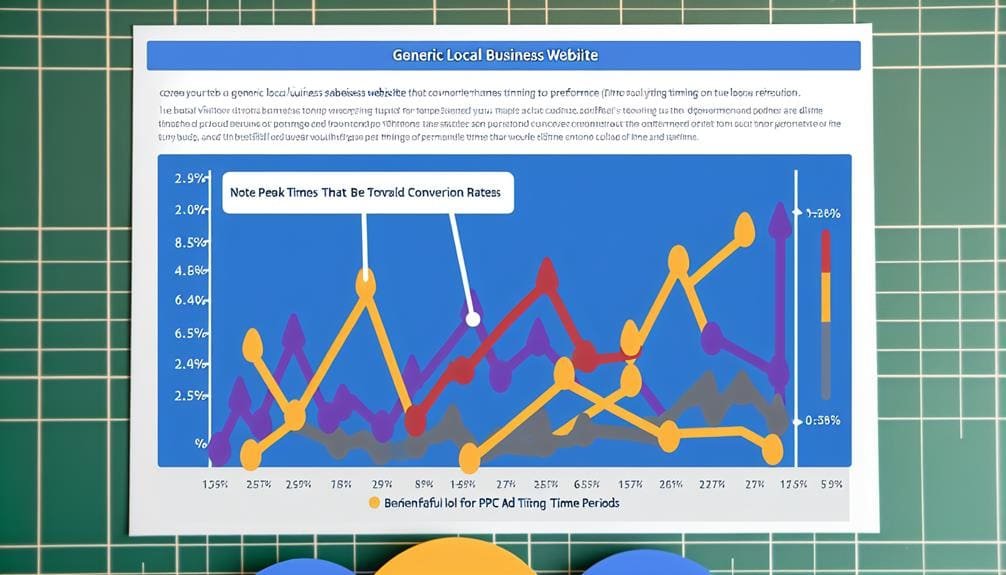
In the world of local PPC advertising, timing is everything. We've all experienced the frustration of seeing an ad at the wrong time or missing out on a great deal because the ad didn't show up when we needed it. But fear not, because there are six key timing techniques that can make all the difference in maximizing the impact of your local PPC ads. These strategies are not only backed by data but also tailored to suit the specific needs of local businesses, ensuring that your ads reach the right audience at the right moment. So, if you're looking to harness the power of precise ad timing to supercharge your local marketing efforts, you won't want to miss out on these game-changing techniques.
Optimal Ad Scheduling Strategies
We have found that implementing precise ad scheduling strategies is crucial in maximizing the impact of local PPC campaigns. Local PPC advertising relies heavily on reaching the right audience at the right time, making ad scheduling strategies essential. By leveraging location targeting and understanding peak times for local searches, ad scheduling can help ensure that ads are displayed when the local audience is most active on search engine results pages. Furthermore, ad extensions and proximity ads can be utilized effectively through ad scheduling to capture the attention of potential customers when they are in close proximity to the business location.
The data-driven nature of ad scheduling strategies allows for real-time adjustments based on performance metrics, ensuring that local PPC campaigns are consistently optimized for maximum impact. Understanding the behaviors and preferences of the local audience is key to crafting effective ad scheduling strategies. By aligning PPC strategies with the specific needs and habits of the local audience, businesses can significantly enhance their visibility and engagement within the local market.
Peak Hour Ad Placement
We've discovered that targeting ads during peak hours can significantly boost engagement and conversions. By identifying the optimal peak hours and strategically scheduling ads, businesses can maximize their impact on the local audience. This data-driven approach allows us to make the most of our advertising budget, ensuring that our messages reach the right people at the most effective times.
Optimal Peak Hours
To maximize the impact of your local PPC ads and increase the likelihood of conversions, strategically timing your ads to coincide with the times when your local audience is most active and likely to engage is essential. Identifying the optimal peak hours for your target audience is crucial for effective ad placement. By analyzing data on local search behavior and location, you can pinpoint the times when your audience is most active. This allows you to allocate your ad spend more efficiently, ensuring that your ads are displayed when they are most likely to generate engagement. Utilizing ad scheduling tools can further enhance your ability to reach your target audience during peak hours. Understanding the patterns of local search behavior and leveraging this knowledge in your ad timing strategy can greatly benefit your local business's search engine marketing efforts.
Targeted Ad Scheduling
Targeted ad scheduling strategically places ads during peak hours when local audiences are most active and engaged, maximizing ad visibility and potential engagement. This local PPC management tactic allows businesses to specifically target local searchers in a specific geographic area, optimizing ad exposure to local customers. By aligning ad scheduling with peak hours, local businesses can ensure that their ads are seen when local customers are most likely to convert, leading to increased click-through rates and conversions for local campaigns. This precision in ad scheduling not only maximizes the impact of local marketing tactics but also helps businesses make the most out of their budget by focusing spending on times when it's most likely to yield results. Implementing targeted ad scheduling is a crucial aspect of local PPC management for businesses striving to stay competitive in the digital landscape.
Dayparting Techniques

Dayparting techniques in local PPC allow businesses to strategically schedule their ads based on the most active and high-converting times of the day. By utilizing this method, businesses can effectively target their local audience at the most opportune moments, optimizing ad visibility during peak hours. This not only enhances the likelihood of conversions but also ensures efficient budget allocation by focusing on periods with the highest potential for engagement. Effective dayparting can significantly improve ad performance and maximize the return on investment for local PPC campaigns.
- Optimizing Ad Visibility: Dayparting enables businesses to ensure that their ads are prominently displayed during the times when their target audience is most active on the search engine results page.
- Maximizing Budget Allocation: By focusing ad spend on high-converting hours, dayparting allows for the effective utilization of campaign budgets, resulting in better ROI.
- Enhancing Ad Performance: Implementing dayparting strategies can lead to improved ad performance by aligning the timing of ad displays with peak audience engagement periods.
Dayparting is a crucial aspect of local PPC ad timing techniques, providing businesses with the means to strategically reach and engage their audience during the most impactful hours.
Seasonal Ad Timing Tips
Understanding the local market's seasonal fluctuations allows businesses to tailor their ad timing to align with peak demand periods, optimizing the impact of PPC campaigns. Seasonal ad timing is crucial for local PPC marketing. By adjusting ad timing to coincide with specific seasonal events or holidays, businesses can capitalize on heightened consumer interest and drive more traffic to their landing pages. This strategic approach can significantly improve the effectiveness of ad groups targeted at local keywords. Utilizing ad scheduling features within platforms like Google Ads enables precise control over when ads are displayed, aligning with specific seasonal opportunities. It's also essential to monitor and analyze past campaign performance during different seasons to gain valuable insights for refining ad timing strategies. Leveraging data from Google Search Console and other analytical tools can provide critical information for making informed decisions about seasonal ad timing. By incorporating these seasonal ad timing tips into your PPC strategy, you can maximize the impact of your campaigns and achieve better results.
Local Event Targeting

When it comes to local event targeting for PPC ads, understanding the event schedule is crucial for effective ad timing. By aligning our ad campaigns with specific local events, we can ensure that our message reaches the right audience at the right time. Targeted ad timing during local events can significantly boost engagement and conversion rates.
Event Schedule
During local events, businesses can strategically schedule their ads to target specific geographic areas, maximizing relevance and impact. Leveraging Event Schedule (Local Event Targeting) can effectively connect businesses with local audiences during opportune moments, driving higher engagement and conversion rates. Here are key considerations for implementing Event Schedule in local PPC ad strategy:
- Tailoring ad messaging and promotions to align with the themes and interests of local events enhances audience resonance and response.
- Aligning ad timing with local events allows businesses to capitalize on increased local traffic and engagement, boosting the effectiveness of their PPC campaigns.
- Targeting ads to specific geographic areas during key local events ensures that businesses reach the most relevant audience, maximizing the impact of their local PPC ads.
Targeted Ad Timing
By strategically timing our ads to coincide with local events and activities, businesses can effectively capture the attention of potential customers who are actively engaging with the community. Targeting the right audience by aligning ad timing with local events in a specific local area enhances brand visibility and engagement. Local consumers browsing for relevant information are more likely to notice and engage with ads based on local keywords. Leveraging local PPC search campaigns with targeted ad timing can lead to increased relevance and resonance with the local audience. Incorporating physical address extensions in ads based on local events, such as festivals or community gatherings, can yield higher ad engagement and conversion rates. It's essential to adapt ad timing to local events to ensure that ads are landing at the right moment, maximizing their impact.
Real-Time Ad Adjustments
Real-Time Ad Adjustments enable businesses to swiftly optimize their local PPC campaigns based on ongoing performance tracking, ensuring adaptability to changing market conditions. This technique allows for real-time monitoring of local PPC campaign effectiveness, empowering businesses to make immediate adjustments to ad copy, targeting, and bidding strategies as performance data comes in. Leveraging real-time performance data enables businesses to make timely adjustments, maximizing the impact of their local PPC ads.
- Swift Optimizations: Real-Time Ad Adjustments facilitate quick modifications to ad elements such as copy, targeting, and bidding strategies.
- Adaptive Campaigns: Businesses can ensure their local PPC campaigns remain responsive and adaptive to changing market conditions through real-time adjustments.
- Timely Impact Maximization: Leveraging real-time performance data allows for timely adjustments to maximize the impact of local PPC ads.
Frequently Asked Questions
What Is the Best Strategy for Running Effective PPC Campaigns?
We target keywords, tailor ad copy, and optimize landing pages for local relevance. By managing bids, utilizing ad extensions, and scheduling ads strategically, we maximize engagement. Geo targeting, ad testing, and conversion tracking ensure effective campaigns.
How Do I Optimize PPC Ads?
We optimize PPC ads by strategically using ad scheduling, keyword targeting, and ad extensions. We continuously analyze data from conversion tracking and A/B testing to refine our ad copy, landing pages, and call to action for maximum impact.
How Long Should PPC Ads Be?
We've found that ideal ad length balances attention span with engagement. For local PPC, shorter ad copy often drives higher conversion and click-through rates. Tailoring ad length to target audience behavior and search intent maximizes brand messaging impact.
What Is the Best Time to Run Ads?
We run ads during peak hours to align with audience behavior and maximize geographic targeting. By utilizing ad scheduling, we ensure keyword relevance and demographic analysis. Monitoring ad performance and conversion rates allows us to adjust ad placement based on seasonal trends.
RELATED POSTS
View all



